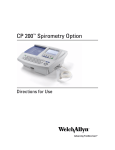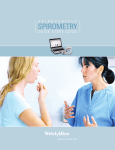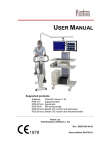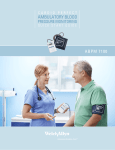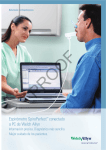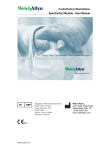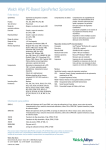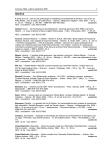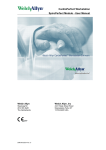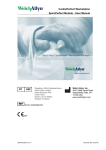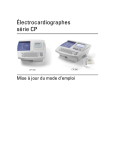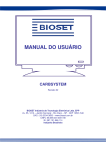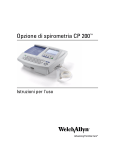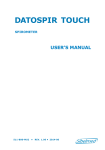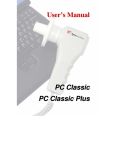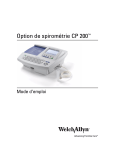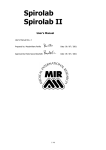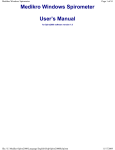Download CP 150 spirometry option Directions for use
Transcript
CP 150 spirometry option Directions for use © 2014 Welch Allyn, Inc. To support the intended use of the product described in this publication, the purchaser of the product is permitted to copy this publication, for internal distribution only, from the media provided by Welch Allyn. Caution: Federal US law restricts sale of the device identified in this manual to, or on the order of, a licensed physician. Welch Allyn assumes no responsibility for any injury, or for any illegal or improper use of the product, that may result from failure to use this product in accordance with the instructions, cautions, warnings, or indications for use published in this manual. Welch Allyn is a registered trademark of Welch Allyn, Inc. CP 150, and CardioPerfect are trademarks of Welch Allyn, Inc. Patent information For patent information, please visit www.welchallyn.com/patents. Software in this product is copyright Welch Allyn or its vendors. All rights are reserved. The software is protected by United States of America copyright laws and international treaty provisions applicable worldwide. Under such laws, the licensee is entitled to use the copy of the software incorporated within this instrument as intended in the operation of the product in which it is embedded. The software may not be copied, decompiled, reverse-engineered, disassembled or otherwise reduced to human-perceivable form. This is not a sale of the software or any copy of the software; all right, title and ownership of the software remains with Welch Allyn or its vendors. Welch Allyn Technical Support: http://www.welchallyn.com/about/company/locations.htm 105661 (CD) DIR 80018004 Ver. F Material Number 720167, DIR 80018004 Ver. F Regulatory Affairs Representative Welch Allyn, Inc. 4341 State Street Road Welch Allyn Limited Skaneateles Falls, NY 13153-0220 U.S.A. Dublin Road www.welchallyn.com Navan Business Park Navan, County Meath Republic of Ireland iii Contents Introduction ............................................................................................. 1 About this document ........................................................................................... 1 Intended use ........................................................................................................ 1 Indications for use ................................................................................................ 2 Contraindications ................................................................................................. 2 Description ........................................................................................................... 2 Features ............................................................................................................... 2 Controls, indicators, and connectors .................................................................... 4 Symbols ............................................................................................................... 7 General warnings ................................................................................................. 8 General cautions .................................................................................................. 9 Setup ...................................................................................................... 11 Connecting the Spirometer ................................................................................ 11 Settings .................................................................................................. 15 Viewing or changing the spirometry settings .................................................... 15 Spirometry home screen ...................................................................... 17 Spirometry home screen ................................................................................... 17 About calibration ................................................................................... 21 Performing a calibration ..................................................................................... 21 Calibrate multiple flows ..................................................................................... 24 Preparing the patient ............................................................................ 27 Spirometry tests .................................................................................... 29 Overview of the testing process ........................................................................ 29 Performing a new Forced Vital Capacity spirometry test ................................... 30 Continue saved test ........................................................................................... 34 Performing a spirometry post test ..................................................................... 36 Working with a Saved test ................................................................................. 37 Troubleshooting .................................................................................... 39 Symptoms and solutions ................................................................................... 39 Maintenance .......................................................................................... 41 Cleaning the spirometer, calibration syringe, and patient handle ...................... 41 Limited warranty ................................................................................................ 42 Service policy ..................................................................................................... 42 iv Contents CP 150 spirometry option Specifications ........................................................................................ 43 Spirometry protocols ............................................................................ 45 About the PCP protocol ..................................................................................... 45 About the NIOSH protocol ................................................................................. 45 About the patient help sheets .............................................................. 47 Adult smokers help sheet .................................................................................. 48 Asthma symptoms help sheet ........................................................................... 49 Predictive Norms, etc. ........................................................................... 51 About Norm extrapolation .................................................................................. 51 About race adjustment ....................................................................................... 51 About composite Norm values .......................................................................... 52 About lung age ................................................................................................... 52 List of Norm-related clinical studies ................................................................... 54 About quality feedback ...................................................................................... 56 Understanding your interpretation results ......................................................... 57 References ......................................................................................................... 58 Glossary ................................................................................................. 59 1 Introduction About this document This manual is written for clinical professionals performing pulmonary function testing. Users must be familiar with measurements and the clinical significance of basic spirometry products. Before using the spirometer, all users and technicians must read and understand this manual and all other information accompanying the CP 150 spirometry option and the CP 150 electrocardiograph. Caregivers need to know how to properly coach patients, to recognize acceptable waveforms, and to know whether results meet ATS reproducibility criteria. The hospital's Biomedical/IT support staff shall require primary skills including disciplines related to maintenance and servicing computer controls/platforms. It is recommended that users attend a certified spirometry training course. The instructions given here are only a guide and should not be used to train a technician. Note This manual supplements the CP 150 electrocardiograph manual, entitled CP 150 12-lead resting electrocardiograph Directions for use. See the electrocardiograph manual for procedures that are common to both ECG and spirometry functions, such as how to move through the menus or how to search for patient data. Intended use The CP 150 spirometry option allows the user to acquire, view, store, and print measures and waveforms of pulmonary function including, but not limited to, maximal volume and flow of air that can be moved in and out of a patient's lungs. These measures are used in the diagnosis and monitoring of lung diseases and interventions for the treatment of certain lung diseases. The spirometer should only be used with patients who are able to understand the instructions for performing the test. 2 Introduction CP 150 spirometry option Indications for use The spirometer is a device that measures lung air volume and airflow rate for pulmonary disease diagnosis and screening. These measurements provide information about a patient's pulmonary function which may be compared with normal values or the patient's previous values. The device is designed to test pulmonary function and obtain spirometric indices for • adult and pediatric patients 12 years and older, • hospital and clinic use only. Contraindications Relative contraindications to performing spirometry: • hemoptysis of unknown origin (forced expiratory maneuver may aggravate the underlying condition) • pneumothorax • unstable cardiovascular status (forced expiratory maneuver may worsen angina or cause changes in blood pressure) or recent myocardial infarction or pulmonary embolus • thoracic, abdominal, or cerebral aneurysms (danger of rupture due to increased thoracic pressure) • presence of an acute disease process that might interfere with test performance (e.g., nausea, vomiting) • recent eye (for example, cataract), thoracic and abdominal surgery • chest and abdominal pain Description • The CP150 is a 12-lead diagnostic ECG device with a spirometry function. • The CP150 spirometry option provides the ability to print test records on an internal printer. • The CP150 spirometry option allows storage of test records in device memory, external storage media, and external software applications. • Automatic interpretation and comparison of best pre-bronchodilator effort to best post-bronchodilator effort • Real-time flow/volume and volume/time graphs on full-color LCD display • Incentive graphics for patient coaching • Multiple predictive norms, including NHANES III • Reduced risk of cross-contamination with Welch Allyn single-use, disposable flow transducers • Patient education help sheets • Instant quality and variability checks for proper test performance • Customizable report formats Features Directions for use Introduction • Meets ATS/ERS 2005 spirometry standards • Single-flow and multiple-flow calibration protocols • NIOSH protocols to create reports that meet agency requirements • PCP (primary care practitioner) protocol that follows NLHEP guidelines • Meets all industry standards, including ATS and NIOSH • Transfer results into the CardioPerfect workstation for easy analysis, reviewing, storing, printing, and exporting • Compliant with the National Lung Health Education Program (NLHEP) guidelines for office spirometers. For more information about NLHEP criteria, visit http:// www.nlhep.org/spirometer-review-process.html. 3 4 Introduction CP 150 spirometry option Controls, indicators, and connectors No. Feature Description 1 LCD screen 800 x 480 pixels color touchscreen provides a graphical user interface. 2 Power switch and LED Power-on/Standby switch. The LED indicates the charging status when connected to AC power: • Green: The battery is charged. • Amber: The battery is charging. 3 Patient cable connector Provides connection for patient cable. 4 Printer Spirometry FVC report Efforts: • All efforts: Prints all efforts. • Three best efforts: Prints the three best efforts of each type that was saved. • Only the best effort: Prints only the best effort of each type that was saved — best FVC, FVC-pre, FVC-post. Note The printer also provides a printout of patient Auto ECG, Stat ECG, or Rhythm ECG. Directions for use Introduction 5 Back view No. Feature Description 1 Ethernet connector Provides a hardwired connection to the computer network. The LEDs indicate active network status when the ethernet cable is connected to a network. 2 Clients USB USB, type "mini B." Provides connection to an enabled host. 3 Host USB USB, type "A." Provides four host USB connections for optional accessories. 4 Power connection Provides an external AC power connection. 5 AC fuse Provides access to AC fuse. 6 Ground lug (equipotential terminal) Provided for electrical safety testing and as a means for connection of a potential equalization conductor. 7 Battery compartment (behind cover) Houses the Li-ion battery. 6 Introduction CP 150 spirometry option Spirometry option back view No. Feature Description 1 Bracket Spirometer sensor mounting bracket 2 Thumb screws Thumb screws to attach bracket to device 3 USB cable Provides spirometer sensor connection to device 4 Spirometer sensor USB spirometer sensor 5 Disposable flow transducers Measures patient air velocity. Connects to pressure tubing. 6 Pressure tubing Connects flow transducer to USB spirometer sensor 7 Patient handle Holds flow transducer and pressure tubing Directions for use Introduction 7 Symbols Documentation symbols WARNING The warning statements in this manual identify conditions or practices that could lead to illness, injury, or death. Caution The caution statements in this manual identify conditions or practices that could result in damage to the equipment or other property, or loss of data. This definition applies to both yellow and black and white symbols. Consult Directions for Use, Electronic version available at Welchallyn.com, or Hard copy DFU available from Welch Allyn within 7 days. Meets essential requirements of European Medical Device Directive 93/ 42/EEC. Shipping, storing, and environment symbols This end up Keep dry Fragile Relative humidity limit Temperature limits Atmospheric air-pressure limits Separate the battery from other disposables for recycling Recycle Separate the device from other disposables for recycling. China RoHS (restriction of hazardous substances) symbols for control of pollution caused by electronic information products. 5-year environment-friendly use period (EFUP) for batteries. 10-year EFUP for the device. For details, see the accompanying documentation. See www.welchallyn.com/weee. Lithium ion battery Keep away from sunlight 8 Introduction CP 150 spirometry option Expiration date 20XX-XX IP20 Protected against the ingress of solid foreign objects ≥ 12.5 mm diameter, not protected against the ingress of water. Miscellaneous symbols Manufacturer Type BF applied part Reference/Model number Serial number Reorder/Catalog number Batch code Professional use only Do not reuse Conforms with IEC/UL/CSA/EN 60601-1 Intertek ETL listed General warnings The following warning statements apply to spirometer use in general. Warning statements that apply specifically to particular procedures, such as preparing the patient for testing, appear in the corresponding sections of the manual. Warnings indicate conditions or practices that could lead to illness, injury, or death. WARNING The spirometer captures and presents data reflecting a patient’s physiological condition. When reviewed by a trained physician or clinician, this data can be useful in determining a diagnosis. However, the data should not be used as a sole means for determining a patient’s diagnosis. WARNING To minimize the chance of a misdiagnosis, it is the physician’s responsibility to assure that spirometry tests are properly administered, evaluated, and interpreted. WARNING To prevent the spread of infection, do not try to clean the flow transducers and nose clips. Discard these items after a single patient use. WARNING Keep the reusable patient handle clean. Patient contact with contaminated equipment can spread infection. Directions for use Introduction 9 WARNING Read and observe all safety information provided in the flow transducer instructions. General cautions The following caution statements apply to spirometer use in general. Caution statements that apply specifically to particular procedures appear in the corresponding sections of the manual. Cautions indicate conditions or practices that could damage the equipment or other property. CAUTION Do not clean the spirometer or any of its components. Trapped moisture in the pressure tubing or sensor could affect their accuracy. Replace the pressure tubing when it becomes dirty. Replace the sensor when it becomes faulty. Recalibrate the spirometer after replacing any components. CAUTION Do not immerse any part of the spirometer into a cleaning liquid or sterilize it with hot water, steam, or air. CAUTION Do not use aromatic hydrocarbons, rubbing alcohol, or solvents on the spirometer. CAUTION If you choose to clean the calibration syringe, wipe the outer surface of the calibration syringe with a clean cloth slightly dampened with 70 percent isopropyl alcohol. CAUTION Use only parts and accessories supplied with the device and available through Welch Allyn. The use of accessories other than those specified may result in degraded performance of this device. CAUTION When you put the spirometer away, store its pressure tubing in a basket or drawer or other place that prevents compression or kinking. CAUTION Avoid installing the spirometer in direct sunlight or in a location where it may be affected by significant changes in humidity, ventilation, or airborne particles containing dust, salt, or sulfur. CAUTION Keep the spirometer away from splashing fluids. 10 Introduction CP 150 spirometry option 11 Setup Connecting the Spirometer WARNING To prevent the spread of infection, use a new flow transducer for each patient. Use rubber gloves when replacing used flow transducers, and wash hands after touching them. Discard flow transducers after a single patient use. Connecting the spirometer components 1. Attach the right side of the spirometer mounting bracket to the device using one of the thumb screws. Tighten the thumbscrew. 2. Insert the spirometer sensor into the mounting bracket. Ensure that the spirometer sensor label is visible in the mounting bracket window so that the mini USB cable connector installs correctly during the next steps. 3. Attach the left side of the spirometer mounting bracket to the device using the second thumb screw. Tighten the thumbscrew. 12 Setup CP 150 spirometry option 4. Insert the mini USB cable connector into the spirometer sensor mini USB port. a. Insert the USB cable into the spirometer sensor mounting bracket groove to secure the cable. b. Insert the USB cable connector into the device's first USB port, furthest to the right. Note The mounting bracket is designed to protect the spirometer sensor and USB cable and only accepts the USB cable mini connector when the spirometer sensor label faces outward. 5. Verify that the spirometer sensor and pressure tubing are clean and undamaged. Look for signs of deterioration, including but not limited to cracks, cuts, discoloration, or oxidation. If any part exhibits any of these symptoms, replace it. a. Attach the pressure tubing to the spirometer sensor. b. Attach a flow transducer to the pressure tubing. CAUTION Hand-tighten the spirometer sensor and flow transducer connectors to avoid damaging the connectors. The CP 150 software automatically activates the spirometry functions throughout the software. Once the software recognizes the sensor, the Spirometry button appears in the Content area. Directions for use Setup 6. Push the flow transducer down onto the patient handle until it is secure. WARNING Keep the reusable patient handle clean. Patient contact with contaminated equipment can spread infection. Note Clean the patient handle after each patient use. 13 14 Setup CP 150 spirometry option 15 Settings Viewing or changing the spirometry settings • The spirometry settings control the predictive norms, parameters, formulas, and content of your report. To view or change the settings 1. Touch the Settings tab. The ECG tab and the vertical ECG configuration tab appear. 2. Touch the Spirometry tab. The vertical Spirometry configuration tab appears. Modify the settings as desired: The following settings are saved as they are selected. Note • Protocol • Predictive norm • Incentive options • Best effort formula • FVC reversibility formula Touch the (Next) button. Modify the settings as desired: • FEV1% formula • Printer ○ Internal ○ PDF to USB ○ PDF to remote file location ○ Internal and PDF to USB ○ Internal and PDF to remote file location • Enable ATS interpretation • Composite norm values Touch the (Next) button. Modify the settings as desired: • Temperature unit 16 Settings CP 150 spirometry option • Pressure unit • Flow unit Touch the FVC report tab. Modify the settings as desired: • Efforts • Lung age • Quality grades • Print “ATS Reproducibility Not Met” Touch the (Next) button. Modify the settings as desired: • First name • Smoke years • Packs/day • Age or Birth date • Middle initial • Weight • Comments Touch the Parameters tab. Modify the settings as desired: Note Touch the Select up to eight parameters to display and print. (Next) button to view additional parameters. Touch the Spirometry calibration tab. Modify the settings as desired: • Touch Calibrate single flow. • Touch Calibrate multiple flows. • Touch Print report. • Enable daily reminder 17 Spirometry home screen Spirometry home screen The Spirometry home screen includes the following areas: Item Area 1 Device status 2 Content 3 Navigation Device status area The Device status area, located at the top of the Spirometry home screen, displays: • Time and date • Battery status • Error or information messages. These items are displayed until the condition has been resolved. 18 Spirometry home screen CP 150 spirometry option Content area The Content area includes 2 test selection buttons, a calibrate button, and a button to change the test type: • Forced Vital Capacity test • Continue saved test • Calibrate • Change test type The content area also provides shortcuts to several controls. About the test types FVC Perform new Forced Vital Capacity test “FVC” stands for forced vital capacity. The goal of an FVC effort is to measure the volume forcefully. Continue saved test A test that provides data to compare with pre-test data. Sometimes called post-Rx or postBD (bronchodilator). A post-test must follow a pre-test within 24 hours. ECG Change test type: Auto ECG • A report typically showing a 10-second acquisition of 12 leads of ECG information combined with patient data, measurements, and optional interpretation. Auto ECGs can be saved to the electrocardiograph’s test directory or to a USB mass-storage device. Rhythm ECG • A continuous, real-time printout of rhythm strips with a user-defined lead configuration. Rhythm ECGs are printouts only. They cannot be saved. Stat ECG • An auto ECG that starts without waiting for you to enter patient data. Directions for use Spirometry home screen 19 Navigation area The Navigation area includes the following tabs: • Spirometry home: Displays spirometry test types and provides shortcuts to several controls. • Manage worklist: Includes patient data entered manually or orders downloaded when connected to a hospital information system. • Saved tests: Accesses the patient spirometry and ECG tests. • Settings: Accesses device configuration settings. To navigate to a tab, touch the tab in the Navigation area with the corresponding name. The active tab is highlighted. 20 Spirometry home screen Example spirometry report CP 150 spirometry option 21 About calibration The American Thoracic Society recommends calibrating a spirometer every day before testing. In addition, each time you open a new package of flow transducers, verify the lot number on the package label. If this lot number differs from the lot number used during the most recent calibration, you must recalibrate the spirometer before resuming testing. There are two types of calibration: Single-flow calibration • One inhale/exhale cycle Multiple-flow calibration • Three inhale/exhale cycles at three different rates: ○ 3 L in 1 second (3 L/s) ○ 3 L in 3 seconds (1 L/s) ○ 3 L in 6 seconds (0.5 L/s) CAUTION For proper performance, the calibration syringe must be recalibrated every year. See the syringe's calibration certificate for the most recent calibration date. When the syringe is due for recalibration, return it to the manufacturer. Performing a calibration Calibrate single flow CAUTION To avoid the risk of cross-contamination, always use a new flow transducer when calibrating the spirometer. Observe all safety information that came with the flow transducers. 1. From the ECG Home screen touch the 2. Touch the (Spirometry) button. (Calibrate) button. The Spirometry calibration screen appears. 3. Touch the Calibrate single flow button. Fill in these fields: • Transducer lot code • Transducer calibration code • Syringe Vol. (in ml) 22 About calibration CP 150 spirometry option Note Obtain the transducer lot and calibration codes from the transducer package label. Note For the syringe volume, see the sticker on the calibration syringe. Note Humidity (%), Temperature, and Pressure are set through the USB spirometer sensor and are not editable fields. The temperature must be 10°– 40° C, 50°–104° F. The atmospheric pressure must be 600 –1100 mbar, 450 – 825 mmHg, 18 – 32 inHg, 60 – 110 kPa. 4. Touch the (Next) button. 5. Connect a new flow transducer to the pressure tubing. 6. Attach the flow transducer to the syringe’s port, as shown in the illustration. Push the flow transducer all the way in for a tight seal. 7. Touch the Continue button. CAUTION Several things may affect calibration results: movement of the syringe, movement of the pressure tubing, or blockage of air. Place the syringe on a hard, level surface with at least 1 cubic meter of open air surrounding the flow transducer. Place your hand on top of the syringe to prevent movement. 8. Touch the Start button to begin the calibration. 9. When the black bar begins to move, push the plunger all the way in, then pull it all the way out, carefully following the black bar’s rate. Use a steady motion in both directions. Directions for use About calibration The results display for a single-flow calibration after no air has moved for three seconds. 10. Review the results. Note Check the error percentages for the expired and inspired volumes. Both volumes must be less than ±3.5% for the calibration to be acceptable. For single-flow calibrations, the measured and adjusted curves should match. Note The syringe used to check the volume calibration of spirometers must have an accuracy of 15 mL for a 3-L syringe. 11. Touch the Accept button to save the calibration results. 23 24 About calibration CP 150 spirometry option Calibrate multiple flows 1. From the ECG Home screen touch the 2. Touch the (Spirometry) button. (Calibrate) button. The Spirometry calibration screen appears. 3. Touch the Calibrate multiple flows button. Fill in these fields: • Transducer lot code • Transducer calibration code • Syringe Vol. (in ml) Note Obtain the transducer lot and calibration codes from the transducer package label. Note For the syringe volume, see the sticker on the calibration syringe. Note Humidity (%), Temperature, and Pressure are set through the USB spirometer sensor and are not editable fields. The temperature must be 10°– 40° C, 50° –104° F. The atmospheric pressure must be 600 – 1100 mbar, 450 – 825 mmHg, 18 – 32 inHg, 60 – 110 kPa. 4. Touch the (Next) button. 5. Connect a new flow transducer to the pressure tubing. 6. Attach the flow transducer to the syringe’s port, as shown in the illustration. Push the flow transducer all the way in for a tight seal. 7. Touch the Continue button. Directions for use About calibration CAUTION Several things may affect calibration results: movement of the syringe, movement of the pressure tubing, or blockage of air. Place the syringe on a hard, level surface with at least 1 cubic meter of open air surrounding the flow transducer. Place your hand on top of the syringe to prevent movement. 8. Touch the Start button to begin the calibration. 9. When the black bar begins to move, push the plunger all the way in, then pull it all the way out, carefully following the black bar’s rate. Use a steady motion in both directions for 2 more times. Touch the Start button to begin each calibration. When no air has moved for three seconds, the multiple flows results display. 10. Review the results. Note Check the error percentages for the expired and inspired volumes. The 0.5,1.0, and 3.0 L/s expired and inspired volumes must be less than ±3.5% for the calibration to be acceptable. Note The syringe used to check the volume calibration of spirometers must have an accuracy of 15 mL for a 3-L syringe. 11. Touch the Accept button to save the calibration results. 25 26 About calibration CP 150 spirometry option 27 Preparing the patient To prepare patients for any spirometry test, explain the entire procedure for the type of effort you want them to perform. Remind patients that the test is painless. Demonstrate at least one effort for the patient. The accuracy of a spirometry test is highly dependent on the patient's understanding and cooperation. So, be prepared to coach and encourage the patient with your “body language” and your words — for example, ”Blow, blow, blow, keep blowing until you can't blow any more out” — to ensure a good effort with reproducible results. Instruct patients to do the following: • Loosen any tight articles of clothing that might constrict lung function, for example, a tight belt, tie, vest, bra, girdle, or corset. • Remove any foreign objects from the mouth, including loose dentures. Note Use of a nose clip is optional. Patients may also pinch their nose. • Place your lips and teeth around a new transducer, sealing your lips tightly around the transducer. Grip slightly with your teeth in the groove. If you need to hold the flow transducer in your hand, keep fingers away from the screen on the back. Blocking even part of this screen creates back-pressure, which makes the percent prediction value very high (as much as 200% or 300%), and we will need to discard the data. • Avoid bending forward as you blow. This also creates back-pressure. • Keep your tongue away from the flow transducer to avoid blocking it. • Keep your chin up so as not to restrict the airway. WARNING Patients may become faint, light-headed, dizzy, or short of breath during spirometry testing. Watch patients closely. If they choose to stand during testing, keep a chair immediately behind them. If there is any reason for concern, stop the test and take proper action. WARNING Patients should not bite on the flow transducer. Biting could result in sharp edges, which could injure the mouth. Note The performance of the spirometer can be affected by the patient spitting or coughing into the spirometer during expiration or by extremes of temperature, humidity and altitude. 28 Preparing the patient CP 150 spirometry option 29 Spirometry tests Overview of the testing process A single test comprises a set of efforts — up to 6 FVC efforts. The 6 efforts of a given type can be a mixture of pre- and post-medication efforts. About FVC efforts “FVC” stands for forced vital capacity. The goal of an FVC effort is to measure the volume and flow of air. Patients inhale fully then exhale forcefully. Sometimes they also inhale forcefully. When ready to begin an FVC effort, you coach the patient through these steps. (If preferred, you may reverse the order of inhaling and exhaling.) 1. 2. 3. 4. Inhale fully — calmly fill your lungs as much as you can. Place the flow transducer in your mouth. Exhale forcefully — as fast as you can, as long as you can. (Optional) Inhale forcefully — as fast as you can, as long as you can. During FVC testing, an optional animated incentive screen provides an alternative way to view the data. This screen gives patients a goal to achieve while exhaling. Touch the Settings tab. Touch the Spirometry tab. Select one of the animation Incentive options from drop down menu. • Fireman • Frog • Dandelion • Birthday About the spirometry parameters During FVC testing, many parameters are measured and calculated. For definitions of these parameters, see the Glossary. During FVC testing, the two most important parameters in determining lung problems are FVC and FEV1. (For a description of how the automatic interpretation software uses these two measurements to determine the degree of obstruction or restriction, see Understanding Your Interpretation Results . • FVC — forced vital capacity, the maximum volume of air that can be forcibly and rapidly exhaled 30 Spirometry tests • CP 150 spirometry option FEV1 — forced expiratory volume 1, the volume of air that is exhaled at one second of a forced expiration About pre- and post-testing If desired, a spirometry test may include both pre- and post-efforts to measure the effectiveness of medication. The “before medication” and “after medication” efforts may be uninterrupted or interrupted. • Uninterrupted — If there is no interruption between pre- and post-efforts (that is, no other patient has been tested and the device has remained on), the same screen continues to display. You simply continue with the procedure. • Interrupted — If there is an interruption (that is, another patient has been tested or the device has been turned off), you need to recall the patient’s test-in-progress before continuing. Pre- and post-efforts must happen on the same day. The next day tests become available for review only; you can no longer add efforts to them. Note About effort replacement You can save up to 6 FVC efforts per test. After saving 6 efforts of a given type, the software compares each new effort with the saved efforts. If the new effort is better than the worst saved effort, the worst effort is deleted and the new one is saved. If the new effort is worse than all saved efforts, you are asked whether you want to save it. If 6 pre-efforts have been saved, the worst pre-effort is deleted when you add a posteffort until you have saved 3 pre- and 3 post-efforts. After that, the “worst” post-effort is deleted. Performing a new Forced Vital Capacity spirometry test CAUTION Patient data is not saved until the spirometry test is completed. The spirometry configuration settings can be changed in the Settings tab. The following settings may appear differently if the default settings have been modified. Note 1. From the ECG Home screen touch the Note 2. Touch the tab appears. (Spirometry) button. If the Daily Reminder setting is enabled, the first time this button is pressed each day, the prompt “calibrate now?” appears. (Perform new Forced Vitals Capacity test) button. The Summary 3. Enter the following patient information: Note Required fields are denoted with an asterisk. • Patient ID*. Touch the OK button. • Birth date*. Touch the OK button. • Last name*. Touch the OK button. Directions for use Spirometry tests 31 • First name. Touch the OK button. • Middle Initial. Touch the OK button. 4. Touch the (Next) button. 5. Enter the following patient information: Required fields are denoted with an asterisk. Note • Gender* • Race* • Height*. Touch the OK button. • Weight. Touch the OK button. • Smoke Years. Touch the OK button • Packs/day. Touch the OK button • Comments. Touch the OK button 6. Touch the (Next) button. 7. Touch the View or Incentive button to select the display information that you want to view during the test. a. Modify the View settings as desired: • View Flow/Volume. (View FV curve) • View Volume/Time. (View VT curve) • View Flow/Volume and Volume/Time. (View FV & VT) • View Parameters. b. Modify the screen settings as desired: • Incentive screen • Curves screen 8. When the patient is ready, touch the Start pre #1 button to perform the spirometry test. Note Coach the patient through the effort. The device stops automatically when air stops moving (that is, when the ATS end-oftest criteria are met). 9. (Optional) touch the Stop button when the test has been completed. 10. Decide whether to accept the effort. 32 Spirometry tests CP 150 spirometry option Note After each effort, a quality message appears on this screen, such as "Blast out harder", “Don’t hesitate,” “Blow out longer,” or “Good effort.” 11. Touch the Accept button to save the pre test and continue or touch the Reject button. If the test is accepted or rejected, the next pre-test will increment in number. Even if some efforts were deleted, the test record indicates the patient’s total number of efforts. 12. Continue with pre-test efforts, when finished touch the Pre-test done button to accept the pre-tests. 13. Touch Print to print the test report, touch Test results to preview the test report on the display, or touch ATS Interpretation to add or edit ATS interpretations. Touch Print patient's education to print patient help sheets. (See About the patient help sheets for further detail.) Touch Start post test to perform post medication efforts for the current patient, or touch Return to pre test to continue with FVC pre-test efforts. Directions for use Spirometry tests 33 14. Touch Done when you have completed the pre-tests. If the Auto Save setting is turned off, touch the Yes button and touch Save to save the test. Select one of the following locations: • Local (internal memory) • USB mass storage device (Any tests that you save to a USB mass storage device can be retrieved only from a CardioPerfect workstation.) • Workstation • Remote file location Performing a spirometry test using the Search tab CAUTION Patient data is not saved until the spirometry test is completed. Note The spirometry configuration settings can be changed in the Settings tab. The following settings may appear differently if the default settings have been modified. 1. Touch the appears. (Perform new Forced Vital Capacity) button. The Summary tab 2. Search for patient. The Search tab gives you access to patient data in the Saved tests directory or in a connected database (CardioPerfect workstation or EMR). • Touch the Search tab. • Enter the Patient ID or Last name. • Touch the OK button. • Touch the Search button. • Touch the Patient name , Patient ID, or Birth date in the Patient name/Patient ID field. • Touch the Select button. • Touch the (Next) button to review or edit patient information. • Touch the (Next) button again. 3. Touch the View or Incentive button to select the display information that you want to view during the test. 34 Spirometry tests CP 150 spirometry option 4. When the patient is ready, touch the Start pre #1 button to perform the spirometry test. See Performing a new Forced Vital Capacity spirometry test for additional details. Note Performing a spirometry test using the Worklist tab CAUTION Patient data is not saved until the spirometry test is completed. The spirometry configuration settings can be changed in the Settings tab. The following settings may appear differently if the default settings have been modified. Note 1. Touch the appears. (Perform new Forced Vital Capacity) button. The Summary tab 2. Touch the Worklist tab. The worklist is downloaded from the EMR. 3. Touch the Order ID, Patient ID, Patient name, or Birth date to select the patient from the Worklist. • Touch the Select button. • Touch the (Next) button to review or edit patient information. • Touch the (Next) button again. 4. Touch the View or Incentive button to select the display information that you want to view during the test. 5. When the patient is ready, touch the Start pre #1 button to perform the spirometry test. Note See Performing a new Forced Vital Capacity spirometry test for additional details. Continue saved test CAUTION Patient data is not saved until the spirometry test is completed. Note The spirometry configuration settings can be changed in the Settings tab. The following settings may appear differently if the default settings have been modified. 1. From the Spirometry home screen touch the The Spirometry saved tests screen appears. (Continue saved test) button. Directions for use Spirometry tests 35 2. Select a patient from the list of saved tests. Touch Patient ID, Patient name, Birth date, or Efforts. 3. Touch the Continue test button. 4. Touch the View or Incentive button to select the display information that you want to view during the test. a. Modify the View settings as desired: • View Flow/Volume. (View FV curve) • View Volume/Time. (View VT curve) • View Flow/Volume and Volume/Time. (View FV & VT) • View Parameters. b. Modify the screen settings as desired: • Incentive screen • Curves screen 5. When the patient is ready, touch the Start post #_ button to perform the spirometry test. Note Coach the patient through the effort. The device stops automatically when air stops moving (that is, when the ATS end-oftest criteria are met). 6. (Optional) touch the Stop button when the test has been completed. 7. Decide whether to accept the effort. 8. Touch the Accept button to save the post test and continue or touch the Reject button. If a test is rejected the next post-test will increment in number. Even if some efforts were deleted, the test record indicates the patient’s total number of efforts. 9. Continue with post-test efforts, when finished touch the Post-test done button to accept the post-tests. 10. Touch Print to print the test report, touch Test results to preview the test report, or touch ATS Interpretation to add or edit ATS interpretations. Touch Print patient's education to print patient help sheets. (See About the patient help sheets for further detail.) Touch Return to post test to continue with FVC post-test efforts. 11. Touch Done when you have completed the post-tests. If the Auto Save setting is turned off, touch the Yes button and touch Save to save the test. Select one of the following locations: 36 Spirometry tests CP 150 spirometry option • Local (internal memory) • USB mass storage device (Any tests that you save to a USB mass storage device can be retrieved only from a CardioPerfect workstation.) • Workstation • Remote file location Performing a spirometry post test Complete the pre-test efforts. See Performing a new Forced Vital Capacity spirometry test. Note Pre- and post-efforts must happen on the same day. The next day tests become available for review only; you can no longer add efforts to them. 1. Touch the (Continue saved test) button. The Spirometry saved tests screen appears. 2. Select a patient from the list of saved tests.Touch the Patient ID, Patient name, Birth date, or Efforts. 3. Touch the Continue test button. 4. When the patient is ready, touch the Start post #_ button. Note Coach the patient through the effort. 5. The device stops automatically when air stops moving (that is when the ATS end-oftest criteria are met.) 6. (Optional) Touch the Stop button when the test has completed. 7. Decide whether to accept the effort. 8. Touch the Accept button to save the post test and continue or touch the Reject button. If a test is accepted or rejected the next post-test will increment in number. Even if some efforts were deleted, the test record indicates the patient’s total number of efforts. 9. Touch Post-test done to accept the post-test. 10. Touch Print to print the test report, touch Test results to preview the test report, or touch ATS Interpretation to add or edit ATS interpretations. Touch Return to post test to continue performing post medication efforts for the current patient. 11. Touch Done when you have completed the post-tests. Directions for use Spirometry tests 37 12. Touch the Yes button and touch Save to save the test. Select one of the following locations: • Local (internal memory) • USB mass storage device (Any tests that you save to a USB mass storage device can be retrieved only from a CardioPerfect workstation.) • Workstation • Remote file location Working with a Saved test To view Saved tests: 1. From the Spirometry home tab, touch the Saved tests tab. Search for tests by Date, Last name, or Patient ID. Alternatively, you can search for All test types. 2. Enter the Date, or Patient's Last name, or Patient's ID and touch OK. Select the Test type. 3. Touch the Search button. 4. Touch the check box next to the desired test to select the test and then touch the Review button. Note The Review button is not active until a test is selected. Only a single spirometry test can be reviewed at a time. Note Spirometry tests are denoted with a icon in the Test type column. 38 Spirometry tests CP 150 spirometry option View and Print options include test efforts with color-coded legend, parameters with norm profile, efforts summary, and ATS Interpretive results. 39 Troubleshooting Symptoms and solutions Problem-solving suggestions: If you try these suggestions and still have problems, contact Welch Allyn. Symptom Possible cause Suggested action Unable to calibrate Poor connection between flow transducer and sensor Check the connection between flow transducer and sensor. Damage to flow transducer Replace the flow transducer if it is damaged. Leak during calibration. Ensure that the connection between the calibration syringe and flow transducer is tight with no leaks. Uneven calibration strokes. Use even strokes in calibration. Pressure tubing is kinked Replace pressure tubing. No sensor detected Poor connection between the sensor and the device Connect to another USB port. Replace the USB cable. Does not print Out of paper Load paper. See the electrocardiograph manual. Paper jam If the paper is jammed, clear it, then reload. Values are too high (intermittent) Patient’s fingers obstructed the screen Retest. on the back of the flow transducer, causing high back pressure and false reading Patient’s lips were not tightly sealed around the flow transducer Retest. Spirometer was calibrated with the wrong size syringe Recalibrate with a 3-liter syringe. See Performing a calibration. 40 Troubleshooting CP 150 spirometry option Symptom Possible cause Suggested action Values are too high (consistently) Pressure connection is partially obstructed Remove any foreign substance from the flow transducer or pressure tubing. Predictive values are blank The selected norm does not support certain values, and composite norm values are disabled Re-enter age/birthdate, height, gender, race. (Fill in the fields. All mandatory fields must be filled in before you can proceed.) Enable composite norm values. See Viewing or changing the spirometry settings. The flow sensor has been dropped. Accident Recalibrate. See Performing a calibration. Report does not print parameters or graphs. Improper parameter settings Check print settings. See Viewing or changing the spirometry settings. Patient test values differ from values expected by physician. Various If the transducer is contaminated with sputum or secretions, replace it. Verify that proper barometric pressure has been entered. See Performing a calibration. Verify the patient data. Eliminate any leaks in the pressure tubing. Retest using a nose clip. Replace the sensor if damaged. Recalibrate. Replace the transducer and retest. 41 Maintenance Cleaning the spirometer, calibration syringe, and patient handle WARNING Change the flow transducer for each patient. WARNING Satisfactory maintenance procedures must be implemented, or equipment failure and health hazards may result. Only qualified service personnel should repair the equipment. CAUTION You cannot clean the spirometer or any of its components. CAUTION Do not clean the pressure tubing or sensor. Trapped moisture could affect accuracy. CAUTION Replace the pressure tubing when it becomes dirty. Recalibrate after replacement. CAUTION Replace the sensor when it becomes faulty. Cleaning the calibration syringe Wipe the outer surface of the calibration syringe with a clean cloth slightly dampened with 70 percent isopropyl alcohol. Cleaning the patient handle WARNING Keep the patient handle clean. Patient contact with contaminated equipment can spread infection. Note Clean the patient handle after each patient use. Clean on a routine basis according to your facility's protocols and standards or local regulations. The following agents are compatible with the patient handle: • 70 percent isopropyl alcohol • 10 percent chlorine bleach solution 42 Maintenance CP 150 spirometry option CAUTION When cleaning the patient handle, avoid using cloths or solutions that include quaternary ammonium compounds (ammonium chlorides) or glutaraldehyde-based disinfectants. Note Disinfect according to your facility's protocols and standards or local regulations. Limited warranty For general information on the limited warranty, see the electrocardiograph manual entitled CP 150 12-lead resting electrocardiograph Directions for use. The following spirometry components have specific warranty periods from date of shipment to customer: • Sensor — 12 months • Calibration syringe — 12 months Service policy For general information on the service policy, see the electrocardiograph manual entitled CP 150 12-lead resting electrocardiograph Directions for use. The following spirometry components have specific service policies. For disposable items, see the Approved Accessories. Flow transducer — Disposable. Pressure tubing — Disposable. Sensor — Return to Welch Allyn for replacement if necessary. Replacement is free within the warranty period. Syringe — Return to the manufacturer for calibration verification if necessary. Recalibration is free within the warranty period. Beyond the warranty period, return to the manufacturer: AM Systems, Inc. 131 Business Park Loop Carlsborg, WA 98324 (800) 426-1306 43 Specifications Item Specification Dimensions and weights Flow transducer 1.5 x 1.2 x 3.3 in. (37 mm x 30 mm x 85 mm) 0.4 oz (12 g) Pressure tubing 2.2 yd (2 m) 0.9 oz (25 g) Sensor 1.2 x 4.3 x 0.6 in (31 mm x 108 mm x 14 mm) 0.9 oz (25 g) Tests FVC, pre- and post-bronchodilator Flow technology Pneumotach Power equipment Powered by CP150 electrocardiograph via USB port (no battery) Current consumption 50 mA Max (30 mA typical) Accuracy Compliant with ATS/ERS 2005 guidelines. Compliant with ISO 26782 guidelines. Reproducibility Compliant with ATS/ERS 2005 guidelines. Compliant with ISO 26782 guidelines. Flow range 0–14 L/s Predictive norms Berglund 1963, Crapo 1981, ECCS / Quanjer 1993, Falaschetti 2004, Forche II, Gore 1995, Gulsvik 2001, Hedenström 1986, Knudson 1976, Knudson 1983, Kory 1961, Morris 1971, NHANES III 1999, Paoletti 1986, Roca 1986, Schoenberg 1978, Viljanen 1981 Interpretation 1991 ATS interpretation standards Lung age calculation can be enabled or disabled. Automatic interpretation can be enabled or disabled. User-definable interpretation statements are also available to be added manually. 44 Specifications CP 150 spirometry option Item Specification Reports FVC testing Volume/time curve Flow/volume curve Both volume/time and displayed curves No curves None Parameters FVC testing FVC, FIVC, FIV1, FIV1%, FEV0.5, FEV1, FEV2, FEV3, FEV5, FEV6, FEV1/FEV6, FEV0.5%, FEV1%, FEV2%, FEV3%, FEV5%, FEV6%, PEF, FEF25, FEF50, FEF75, FEF0.2-1.2, FEF25-75, FEF75-85, PIF, FIF50, FEF50/FIF50, FET Quality checks Effort acceptability and test reproducibility checks. Effort-quality messages and test-quality grades. Visual incentive for assistance in coaching patients. Connectivity Compatible with CardioPerfect workstation. Electrocardio protection against IPXO ingress of water, per IEC 60529 Spirometer protection against IP20 ingress of water, per IEC 60529 Protocols PCP (primary care practitioner), NIOSH, None Environmental operating conditions Temperature +10° C to +40° C (+50° F to +104° F) Relative humidity 15 - 95% noncondensing (30 - 70% for printing) Atmospheric air-pressure limits 700 - 1060 hPa Environmental storage conditions Temperature -20° C to +50° C (-4° F to +122° F) Relative humidity 15 - 95% noncondensing Atmospheric air-pressure limits 700 - 1060 hPa Specifications are subject to change without notice. 45 Spirometry protocols This manual describes the protocols you can select to change the way the CP 150 spirometer operates when testing a patient. Any features that are not specified in the protocol use your own settings. Protocol settings are uneditable after selection to avoid confusion during setup. To learn how to review or change the protocol, see Viewing or changing the spirometry settings. About the PCP protocol The PCP (primary care practitioner) protocol is for users who want to make sure that testing meets the requirement of the National Lung Health Education Program (NLHEP). When the PCP protocol is selected, the spirometer automatically performs as described here, regardless of user-defined settings. When this protocol is selected, testing and reports are affected as follows: Operation Settings • Norm: NHANES III 1999 (Adult) • Best Effort Formula: Best Measurement • FVC Reversibility formula: ((Post-Pre)/Pre)*100 • FEV1% formula: FEV6 • ATS interpretation: True • Composite norms: False • Displaying parameters: FEV1, FEV6, FEV1/FEV6 • Efforts to be printed: Only best effort • Print lung age: True • Print quality grades: True About the NIOSH protocol The NIOSH (National Institute for Occupational Safety and Health, U.S.) protocol is for users who want to make sure that occupational testing and reports meet the requirements of NIOSH. The device automatically performs as described here, regardless of user-defined settings. When using this protocol, the spirometer should be calibrated at three different flows every day before use. 46 Spirometry protocols CP 150 spirometry option When this protocol is selected, testing and reports are affected as follows: Operation Settings • Norm: NHANES III 1999 (Adult) • Best Effort Formula: Best Measurement • Composite norms: False • Efforts to be printed: Three best efforts 47 About the patient help sheets Two patient help sheets are available to print:1 • Adult smokers If Smoke Years is enabled in the FVC report settings, the Smokers' education sheet option can be printed for adult smokers. • Asthma symptoms These help sheets print only if patient education is selected. To enable patient education touch the Print patient's education button after the FVC efforts have been performed. Touch the checkbox next to Asthma education or Smokers' education. The patient's name, FEV1% predicted, and date print automatically on both sheets. If Enable ATS Interpretation is selected, the appropriate recommendation is also marked. To enable ATS Interpretation, touch the Settings tab. The ECG tab and the vertical ECG configuration tab appear. Touch the Spirometry tab. The vertical Spirometry configuration tab appears. Touch the Enable ATS Interpretive. Note (Next) button. Touch the checkbox next to the If no recommendation is marked, the doctor must mark one. 1 Both help sheets come from a booklet entitled Simple Office Spirometry for Primary Care Practitioners, by Thomas L. Petty, MD, and Paul L. Enright, MD. This booklet can be downloaded from the National Lung Health Education Program (NLHEP) home page: http://www.nlhep.org/Pages/Resources.aspx. 48 About the patient help sheets CP 150 spirometry option Adult smokers help sheet Name What Your Lung Function Results Mean For Adult Smokers You have just performed Spirometry, the basic test of how well your lungs are working. The results indicate whether you have developed chronic obstructive pulmonary disease (COPD) due to smoking. COPD occurs in about one of every five smokers after more than 20 years of smoking. COPD slowly “eats away” at the lung's reserves. Affected smokers are often unaware of lung disease until more than half of their lung function has been lost. Spirometry testing can detect COPD many years before symptoms occur. ___ Your test result was within the normal range. You do not appear to be developing COPD. However, as a smoker, you remain at high risk of developing a heart attack, stroke, and/or lung cancer. Call the number at the bottom of this page for help with smoking cessation. ___ Your test result shows mild airways obstruction, suggesting that you are a “susceptible smoker” who already shows signs of early COPD. You are unable to blow out air as quickly as normal (your FEV1/FVC is low). If you continue smoking, you will eventually develop disabling lung disease (in about 10-20 years). If you are able to successfully quit smoking sometime soon, your lung function may return to normal levels and you will probably never develop symptoms of COPD. Call the number at the bottom of this page if you would like information about local resources to help you quit smoking. ___ Your test result shows moderate-to-severe airways obstruction. You have COPD. If you continue smoking, your lung disease will certainly get worse and you will eventually become short of breath while walking, climbing stairs, or doing other exercise. It is very important that you seek help to stop smoking. If you are able to successfully quit smoking sometime soon, you will probably regain a little lung function within three months, and the abnormally rapid decline in your lung function which you have experienced due to smoking will be stopped. Call the number at the bottom of this page for information about local resources to help you quit smoking. Your result: ____________________ FEV1 % predicted For more information contact: ________________________________ Date Directions for use About the patient help sheets 49 Asthma symptoms help sheet Name What Your Lung Function Results Mean For Those With Symptoms Suggesting Asthma You have just performed Spirometry, the basic test of how well your lungs are working. The results may indicate whether you have asthma and its severity. ___ Your test was within the normal range. If you recently had symptoms such as episodes of shortness of breath with wheezing, chest tightness, or cough, you may have asthma, but your lung function is normal today. Consider visiting a physician when you again have asthma symptoms and then repeat this Spirometry test. If you already know that you have asthma, it is in good control. ___ Your breathing test shows mild airways obstruction (some narrowing of your breathing tubes). You are currently unable to blow out air quickly. This result may indicate asthma that is not well controlled. Discuss with your physician medications to better control your asthma. ___ Your breathing test shows moderate-to-severe airways obstruction (narrowing of your breathing tubes). You are currently unable to blow out air quickly. This result usually indicates asthma that is poorly controlled. Discuss with your physician very soon the use of medications that will help to better control your asthma and the value of peak flow monitoring. ___ Your test shows a low forced vital capacity (FVC). Your FVC is the total amount of air that you exhaled, in liters (similar to quarts). Values below about 80% are abnormally low and suggest that you are unable to inhale or exhale as much air as most healthy persons of your age, height, gender, and race. Obesity may be one of the causes of a mildly decreased FVC, and pneumonia is another. Consider asking a physician to review this report at some time during the next couple of months. Your result: ____________________ FEV1 % predicted Your peak flow after inhaling a bronchodilator was ______ L/s (liters per second). You can compare this value to the peak flow that you measure using your own peak flow meter. The two numbers should match within 1 L/s. If your asthma is currently in good control, today's value may be close to your best peak flow reading at home. ________________________________ Date 50 About the patient help sheets CP 150 spirometry option 51 Predictive Norms, etc. About Norm extrapolation Extrapolation is the practice of applying a norm’s formula to a patient who doesn’t fit that norm’s demographics. For example, if you were testing an 88-year-old man, and the primary (selected) norm was based on males 85 or younger, the predicted values would be extrapolated values. • Norm extrapolation is indicated in the test record. • Adult norms allow extrapolation of age up, but not down. • Adult norms allow extrapolation of height, weight, and smoke years, up and down. About race adjustment Although expected values for certain parameters vary significantly between ethnic groups, some norm studies do not include separate regression equations for different races. For those studies, the following table describes the adjustments made by the CP 150 software for the FVC and FEV1 predicted values. Where applicable, norm values are multiplied by the percentages identified in the following table. Race Choices FVC & FEV1 Recommendation Source Caucasian No adjustment — Black 88% ATS Asian 94% NIOSH No adjustment None found Native American 94% NIOSH Polynesian 94% NIOSH Aboriginal 94% NIOSH Indian 94% NIOSH Hispanic Note Race adjustment applies for adults only. If a race adjustment percentage is used, the same adjustment is applied to the LLN value. 52 Predictive Norms, etc. CP 150 spirometry option About composite Norm values When the primary (selected) norm does not support a given parameter — and when composite norm values are enabled in the operation settings — the missing value is filled in from one of the alternative (composite) norm sources, listed here. For example, since the Crapo norm does not support FEV6, this value is filled in from NHANES III. Composite Norm Source Parameters Filled In When Not Supported in Primary Norm NHANES III FVC, FEV1, FEV1%, FEV6, FEV1/FEV6, PEF, FEF25-75 Crapo 1981 FEV0.5, FEV3, FEV3/FVC Morris 1971 FEF0.2-1.2 ECCS/Quanjer 1993 FEF25, FEF50, FEF75 The primary norm takes precedence over the composite source. For example, since the Crapo norm supports the FVC parameter, this value always comes from Crapo, not from the composite source. Composite values are used when the patient does not fit the demographics of either primary norm (adult or pediatric). For example, if the primary norms are Kory and Morris, a 14-year-old patient fits neither norm due to age restrictions. The software would use values from the appropriate composite norms, for example, NHANES III or ECCS/ Quanjer 1993. It would not use values from Kory or Morris. On the screen and in reports, an abbreviation identifies the norm source for each composite value used. For example, the abbreviation for Roca is “ro.” To enable or disable composite norm values, see Viewing or changing the spirometry settings. About lung age Lung age is a calculated value based on a patient’s demographics and spirometric performance that gives a relative indication of the health of the subject's lungs. This value is used primarily to encourage smoking cessation. The CP 150 spirometer calculates lung age values according to the document Short Report Spirometric "Lung Age" Estimation for Motivating Smoking Cessation. (Morris 1995). For single-effort tests, lung age is based on the current effort. Otherwise, it is based on the patient’s “best” effort, as defined in the settings. Lung age results less than 20 years are reported as “<20,” and results greater than 84 are reported as “>84.” This limitation is derived from the subject population on which Morris based his research. Lung age, which is expressed in years, is the average of the four formulas in the Morris article (FVC, FEV1, FEF25-75%, and FEF0.2-1.2). Specifically, lung age is calculated as follows: Gender Lung Age Formula Men [5.920 (height) – 40.000 (FVC) – 169.640 + Directions for use Predictive Norms, etc. Gender Lung Age Formula 2.870 (height) – 31.250 (FEV1) – 39.375 + 2.319 (height) – 21.277 (FEF200-1200) + 42.766 + 1.044 (height) – 22.222 (FEF25%-75%) + 55.844 ]/ 4 Women [4.792 (height) – 41.667 (FVC) – 118.833 + 3.560 (height) – 40.000 (FEV1) – 77.280 + 4.028 (height) – 27.778 (FEF200-1200) – 70.333 + 2.000 (height) – 33.333 (FEF25%-75%)+18.367 ] / 4 53 54 Predictive Norms, etc. CP 150 spirometry option List of Norm-related clinical studies Each of the following studies provides expected values for various spirometric parameters by measuring significant samples of a particular population. Norm Clinical Study Berglund 1963 Reference Spirometric Studies in Normal Subjects: Forced Expiratograms in Subjects 7-70 Years of Age, Berglund, et. al., Acta Medica Scandinavica, volume 173, 1963. Crapo 1981 Reference Spirometric Values using Techniques and Equipment that Meet ATS Recommendations, Crapo, et. al., American Review of Respiratory Disease 1981, 123:659-664. ECCS/Quanjer 1993 Lung Volumes and Forced Ventilatory Flows: Official Statement of the European Respiratory Society, Quanjer, et. al., 1993 European Respiratory Journal, 1993, supplement 16: 5-40. Falaschetti 2004 Prediction equations for normal and low lung function from the Health Survey for England, E. Falaschetti, J. Laiho, P. Primatesta, S. Purdon; European Respiratory Journal 2004; 23: 456–463. Forche II Equations acquired from the Spirometry Norm Study from Dr. Günter Forche, Prim. Univ. Doz. Gore 1995 Spirometric standards for healthy adult lifetime nonsmokers in Australia, C.J. Gore, A.J. Crockett. D.G. Pederson, M.L. Booth, A. Bauman, N. Owen; European Respiratory Journal 1995. 8: 773-782. Gulsvik 2001 Forced Spirometry Reference Values for Norwegian Adults: The Bronchial Obstruction in NordTrondelag Study, Langammer, Gulsvik , et. al., European Respiratory Journal 2001, 18: 770-779. Hedenström 1986 Reference Values for Lung Function Tests in Men: Regression Equations With Smoking Variables, Hedenström, et. al., Upsala Journal of Medicine Science 91:299-310, 1986. Knudson 1976 The Maximal Expiratory Flow-Volume Curve Normal Standards, Variability, and Effects of Age, Ronald J. Knudson, Ronald C. Slatin, Michael D. Lebowitz, and Benjamin Burrows, et. al., American Review of Respiratory Disease, volume 113, 1976. Knudson 1983 Change in the Normal Expiratory Flow Volume Curve With Growth and Aging, Ronald Knudson, et. al., American Review of Respiratory Disease, 1983, 127, 725-734. Kory 1961 The Veterans Administration Army Cooperative Study of Pulmonary Function, Clinical Spirometry in Normal Men, Kory, et. al., American Journal of Medicine, February 1961. Morris 1971 Spirometric Standards for Healthy Non-smoking Adults, James F. Morris, et. al., American Review of Respiratory Disease, volume 103, 1971. NHANES III Spirometric Reference Values from a Sample of the General U.S. Population, John L. Hankinson, John R. Odencrantz, and Kathleen B. Fedan, et. al., Division of Respiratory Disease Studies, National Institute for Occupational Safety and Health, Centers for Disease Control and Prevention, Morgantown, West Virginia, 1999. The Third National Health And Nutrition Examination Survey (NHANES III). Roca 1986 Spirometric Reference Values From a Mediterranean Population; J. Roca, J. Sanchis, et. al.; Bulletin Européen de Physiopathologie Respiratoire , 1986, 22, 217-224. Schoenberg 1978 Growth and Decay of Pulmonary Function in Healthy Blacks and Whites, Janet B. Schoenberg, Gerald J. Beck, and Arend Bouhuys, et. al., Respiration Physiology, 1978, 33, 367-393. Directions for use Predictive Norms, etc. Norm Clinical Study Viljanen 1981 Spirometric Studies in Non-smoking, Healthy Adults, Viljanen, et. al., Journal of Clinical Lab Investigation, 41 supplement 159, 5-20, 1981. 55 56 Predictive Norms, etc. CP 150 spirometry option About quality feedback The spirometer provides two kinds of quality feedback: effort-quality messages and test quality grades, as described in the following sections. About effort-quality messages One of the following effort-quality messages appears on the screen after each effort is completed. These messages indicate whether an effort was acceptable and reproducible, and if not, what the patient needs to do differently. The term “match” here means “variation” or “difference with respect to best test.” Effort-quality message Criteria Don’t hesitate Back-extrapolated volume > 150 ml or 5%, whichever is greater. Blast out faster PEF time > 120 ms. Blow out longer FET < 6.0 seconds, and end-of-test volume > 100 ml (invalid FEV6). Blast out harder PEF is not reproducible (match > 1.0 L/s). Deeper breath FEV6 match > 150 ml FVC may be substituted for FEV6. Good effort Effort meets above criteria. Good test session Two acceptable efforts match. About test-quality grades Another type of feedback is the test-quality grade, as described in the following table. If Quality grades is enabled in the FVC report settings, a grade appears on printed reports and also displays on screen when you view the values or interpretation of a completed test. To enable or disable this setting, see Viewing or changing the spirometry settings. Testquality grade Number of acceptable efforts Reproducibility A 2 or more Largest two FEV1 values match ≤ 100 mL. Largest two FVC values match ≤ 100 mL. B 2 or more Largest two FEV1 values match > 100 and ≤ 150 mL. C 2 or more Largest two FEV1 values match > 150 and ≤ 200 mL. D 1 or more Largest two FEV1 values match > 200 mL. F None Directions for use Predictive Norms, etc. 57 Understanding your interpretation results This diagram shows how the automatic interpretation software uses a patient's FVC and FEV1 results, in comparison with normal values, to determine the degree of obstruction or restriction. This diagram follows the American Thoracic Society’s example for interpretation. 58 Predictive Norms, etc. CP 150 spirometry option References 1. Checklist for Compliance with NLHEP Guidelines for Office Spirometers, National Lung Health Education Program, www.nlhep.org/resources.html#review. 2. Disability Evaluation Under Social Security (the “blue book”), Social Security Administration SSA publication number 64-039, Office of Disability Programs ICN 468600, January 2003. See in particular the calibration and reporting sections of this document. 3. Lung Function Testing: Selection of Reference Values and Interpretive Results, American Thoracic Society, March 1991. This document describes the methods of selecting the reference values and the algorithm for interpretative results. 4. National Occupational Respiratory Mortality System, National Institute for Occupational Safety and Health (NIOSH). 5. Short Report Spirometric “Lung Age” Estimation for Motivating Smoking Cessation, James F. Morris, M.D., and William Temple, Preventive Medicine 14, 655-662 (1985). 6. Standardisation of Spirometry, 2005 Update, ATS/ERS task force: This document describes the methods of acquiring the output parameters and the required accuracy. For details on ATS/ERS acceptability criteria, see these sections in the standard: • "Start of Test Criteria,” page 324 • "Manoeuvre repeatability,“ page 325 7. Standardized Lung Function Testing, European Respiratory Journal, volume 6, supplement 16, March 1993. 8. U.S. Pulmonary Function Standards for Cotton Dust Standard, 29 CFR 1910.1043, Appendix D. 9. Lung Function Testing: Selection of reference values and interpretive strategies. American Thoracic Society, American Review of Respiratory Disease, 144:1202-1218 (1991). 59 Glossary adult. Generally, 18 or older. Age limits vary with each norm. ATS. American Thoracic Society. An organization that provides standards for spirometry common practice and equipment. ATS acceptability Applicable to FVC testing only. (1) Criteria ensuring that an individual effort started and ended criteria. satisfactorily (no leaks or coughs). (2) Criteria ensuring that the patient has made at least two efforts of the same kind (two FVC-pre or two FVC-post), and that these efforts are reproducible. For details, see document Standardisation of Spirometry, 2005 Update, ATS/ERS task force: This document describes the methods of acquiring the output parameters and the required accuracy. For details on ATS/ERS acceptability criteria, see these sections in the standard: • “Start of Test Criteria,” page 324 • “Manoeuvre repeatability,“ page 325 ATS interpretive results. The software generates interpretive results as described in Lung Function Testing: Selection of Reference Values and Interpretive Results, American Thoracic Society, March 1991. This document describes the methods of selecting the reference values and the algorithm for interpretative results. baseline. See pre-test. best effort. A measurement calculated from a set of efforts. The formula for calculating best effort is userselectable: (1) the single best effort or (2) a composite of best parameter values. BF. Breathing frequency. See also MV and tidal breathing. bronchospasm evaluation. See post-test. BTPS. Body conditions, normal body temperature (37° C), ambient pressure, saturated with water vapor. The BTPS correction factor converts ambient conditions — temperature, humidity, and pressure — to BTPS. CardioPerfect workstation. A PC using Welch Allyn CardioPerfect software. Stores ECG and spirometry test data. Can communicate with other electronic patient-information systems, such as billing and medical records. composite norm value. A value that is filled in from another norm — a “composite norm source” — when the primary (selected) norm does not support a given parameter. Applicable only when composite norm values are enabled. 60 Glossary CP 150 spirometry option COPD. Chronic obstructive pulmonary disease. Characterized by airflow obstruction that is primarily caused by smoking. Examples include emphysema, chronic bronchitis, and asthmatic bronchitis. curve. A graphical display of spirometry data. During SVC testing, only one curve type is available: volume/ time. During FVC testing, four curve types are available: volume/time, flow /volume, tidal volume, and (on screen only) incentive. effort. A single spirometry maneuver, for example, one blow. A single test comprises multiple efforts. See also best effort. ERS. European Respiratory Society. ERV. Expiratory reserve volume (in liters). The maximum volume that can be expired from the level of the functional residual capacity (FRC). See also tidal breathing. extrapolation. The practice of applying a norm’s formula to a patient who doesn’t fit that norm’s demographics. For example, if you were testing an 88-year-old man, and the primary (selected) norm were based on males 85 or younger, the predicted values would be extrapolated values. FEF50/FIF50. The ratio of these two parameters. See FEF50 and FIF50. FEF25. Forced expiratory flow (in L/s) at 25% of FVC. FEF50. Forced expiratory flow (in L/s) at 50% of FVC. FEF75. Forced expiratory flow (in L/s) at 75% of FVC. FEF85. Forced expiratory flow (in L/s) at 85% of FVC. FEF0.2-1.2. Forced expiratory flow average (in L/s) between 0.2 and 1.2 liters of FVC. FEF25-75. Forced expiratory flow average (in L/s) during the middle half of FVC. FEF75-85 (“late” FEF). Forced expiratory flow average (in L/s) between 75% and 85% of FVC. FET. Forced expiratory time (in seconds). The elapsed time from the beginning of expiration until a specified percentage of FVC. FEV0.5. Forced expiratory volume (in liters) at 0.5 seconds. FEV1. Forced expiratory volume (in liters) at 1 second. An important parameter because it reflects the severity of COPD. FEV1/FEV6. The ratio of these two parameters. See FEV1 and FEV6. FEV2. Forced expiratory volume (in liters) at 2 seconds. FEV3. Forced expiratory volume (in liters) at 3 seconds. FEV5. Forced expiratory volume (in liters) at 5 seconds. FEV6. Forced expiratory volume (in liters) at 6 seconds. FEV0.5%. FEV0.5 as % of FVC. Directions for use Glossary 61 FEV1%. FEV1 as % of FVC. Same as FEV1/FVC. A parameter for a single FVC effort. FEV1% formula. A user-selectable formula that determines the calculation method for a test’s (not an effort’s) overall FEV1% value, which affects the automatic interpretation. FEV2%. FEV2 as % of FVC. FEV3%. FEV3 as % of FVC. FEV5%. FEV5 as % of FVC. FEV6%. FEV6 as % of FVC. FEVt. Timed forced expiratory volume (in liters). Volume of air exhaled in the specified time during an FVC effort. FIF50. Forced inspiratory flow (in L/s) at 50% of FIVC. FIV1. FIV1 as % of FIVC. FIVC. Forced inspiratory vital capacity (in liters). The maximum volume of air that can be inspired during forced inspiration starting from full expiration. FIVt. Timed forced inspiratory volume (in liters). Volume of air inhaled in the specified time (t). flow. The speed at which air is inhaled or exhaled (in L/s). flow = f(v). See flow/volume. flow/volume. Same as flow over volume or flow = f(V). A type of data curve available during FVC testing. The y axis represents flow (L/s); the x axis represents volume (liters). flow loop. A flow/volume curve that includes inspiratory data (negative values on the y axis). FRC. Functional residual capacity (in liters). Volume of air remaining in the lungs and airway at the average end-expiratory level. FVC. Forced vital capacity. (1) A type of test in which patients inhale fully and exhale forcefully for as long as they can. The goal: to measure the volume and flow of air. May or may not include forced inhaling. When forced inhaling is included, it may be done either before or after exhaling. See also flow loop. (2) An important parameter (in liters): the maximum volume of air that can be delivered during forced expiration starting from full inspiration. IC. Inspiratory capacity (in liters). The maximum volume of air that can be inhaled after a normal — unforced — exhalation. See also tidal breathing. incentive screen. An animated screen that gives patients — usually children — a goal to achieve while exhaling. This screen is listed as a type of “curve” (data display) available during FVC testing. IRV. Inspiratory reserve volume (in liters). The maximum volume that can be inspired from the average end-inspiratory level. See also tidal breathing. LLN. Lower limits of normal. The lowest expected value for a spirometric parameter. The method of determining this value varies from norm to norm. loop. See flow loop. 62 Glossary CP 150 spirometry option lung age. A calculated value based on a patient’s demographics and spirometric performance that gives a relative indication of the health of the subject's lungs. This value is used primarily to encourage smoking cessation. Lung age is not available for patients under 20 years of age. maneuver. See effort. MV. Minute volume (in liters). MV = BF x VT. See also tidal breathing. NIOSH. National Institute for Occupational Safety and Health (U.S.). norm. A research-based spirometry data set with a specific profile for race, gender, age, and height. The software compares each patient’s results with data in the primary (selected) norm, reporting the results as percentages of the predicted (normal) values. normal. Consistent with norm data. OSHA. Occupational Safety & Health Administration (U.S.). parameter. A commonly defined attribute of a spirometric waveform (FVC, FEV1, and so on). pediatric. Generally, under 18 years old. Age limits vary with each norm. Also, young children’s lung sizes vary greatly. Norm values and interpretive results are not available for patients under 3 years of age. PEF. Peak expiratory flow (in L/s). The largest expiratory flow achieved with a forced effort. PIF. Peak inspiratory flow (in L/s). The largest inspiratory flow achieved with a forced effort. post-test. A test that provides data to compare with pre-test data. Sometimes called post-Rx or post-BD (bronchodilator). A post-test must follow a pre-test within 24 hours. See also reversibility. predictive curve. A curve that follows a set of predictive points. predictive points. Key values from the selected norm and from composite norms (if enabled). Applicable for FVC tests only. For flow/volume curves, predictive values are PEF, FEF25, FEF50, FEF75, and FVC (all represented as points). For volume/time curves, predictive values are FEV1 (represented as a point) and FVC (represented as a horizontal line). If predictive points are enabled, all available predictive values appear on the screen and the printout. pre-test. A test that provides a baseline for comparison with a post-test taken by the same patient. Sometimes called pre-Rx or pre-BD (bronchodilator). Pre-tests and post-tests are commonly used to evaluate the effectiveness of medication. See also reversibility. reversibility. The percentage difference between pre-test and post-test data. This measurement indicates the effect of medication on lung function. Reversibility applies to each parameter separately. The reversibility formula, which determines the way in which reversibility is calculated, is userselectable. SVC. Slow (relaxed) vital capacity. (1) A type of test in which patients breathe normally several times, then inhale maximally and exhale maximally, or vice versa. Sometimes SVC testing is used when forced breathing is impossible. The patient inhales and exhales as completely as possible, as in FVC testing, but the breathing is not forced. The goal of an SVC effort is to measure the volume of air inhaled and exhaled, not the air flow (speed). (2) An important parameter (in liters): the maximum volume of air exhaled from the point of maximum inhalation, or maximum volume of air inhaled from a point of maximum exhalation. Directions for use Glossary 63 test. A set of efforts — up to 6 efforts of each type (FVC and SVC) for a maximum of 12 efforts (6 FVC and 6 SVC). The 6 efforts of a given type can be a mixture of pre-medication and post-medication efforts. Tex. Tidal breathing expiration time (in seconds). See also tidal breathing. tidal breathing. Multiple breaths, normal breathing. May be used during FVC or SVC testing. After measuring tidal breathing for several seconds, the following parameters can be extrapolated: MV, VE, BF, and Tin/Tex. If you combine a VT measurement with a VC measurement, you can also calculate the ERV, IC, and IRV. For example, COPD patients have a higher ERV and a lower IC and IRV. tidal volume. See VT. tidal volume curve. A flow loop that includes all data from all breaths, tidal and forced. Tin. Tidal breathing inspiration time (in seconds). See also tidal breathing. Tin/Tex. The ratio of Tin and Tex. See also Tin and Tex. TV. See VT. variance. The difference between the best and worst efforts for a parameter (FEV1, FVC, and so on). Pre¬test and post-test variances are reported separately. See also best effort. VC. Vital capacity. See FVC or SVC. VE. Ventilation in L/min. See also tidal breathing. vital capacity. See FVC or SVC. volume = f(t). See volume/time. volume/time. Same as volume over time or volume = f(t). A type of data curve available during both FVC and SVC testing. The y axis represents liters; the x axis represents seconds. VT. Tidal volume (in liters). Also called TV, although VT is the preferred abbreviation. The volume of air that enters the lungs during inspiration and leaves the lungs during expiration in a normal breathing cycle. One of the most important parameters in SVC testing. See also MV, tidal breathing, and tidal volume curve. workstation. See CardioPerfect workstation. Material No. 720167




































































